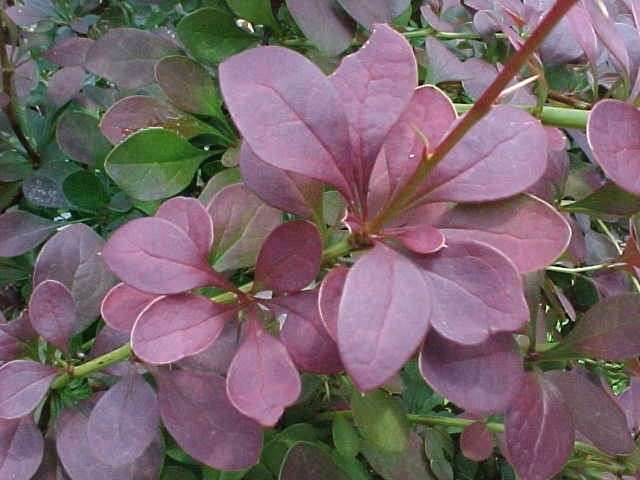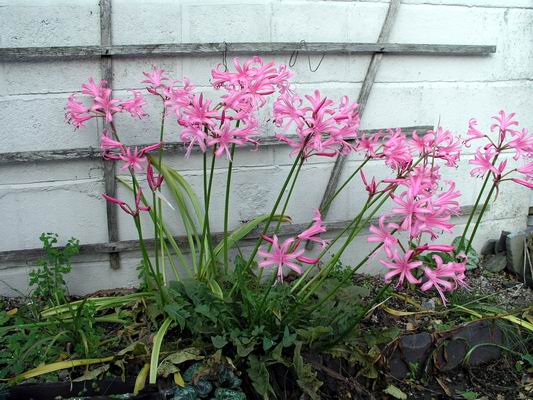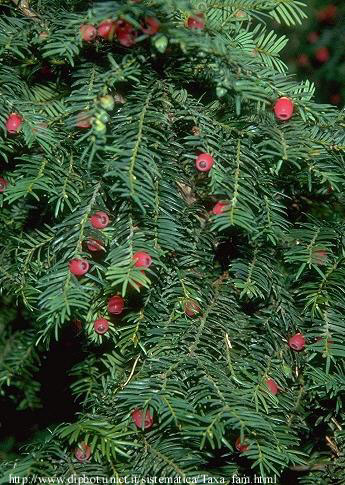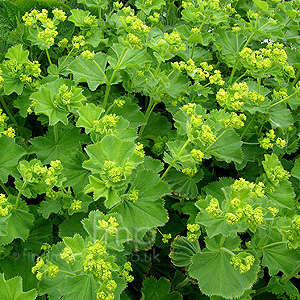Berberis thunbergii atropurpurea - purple barberry
 |
| (Image source) |
Small deciduous shrub with berries and a purple foliage which turns red in the autumn . Used in shrubberies and is excellent for low, thorny hedging.
*RHS award of garden merit
Size: 1 x 2.5 m
 |
| (Source) |
Cultivation notes:
Shrub; plant November to March, add 5 cm layer of mulch and water in drought.
When used as a hedge, trim after flowering.
Plant note: the B. thunbergii atropurpurea group has a number of cultivars of varying sizes, colours and habits.
Nerine bowdenii 'Pink Beauty' - Nerine
 |
| (Source) |
An autumn and late summer flowering bulbous perennial with showy pink flowers.
*RHS award of garden merit
Size: 8 x 45 cm
Cultivation notes:
Plant bulbs in early spring in well drained soil in full sun.
Taxus baccata - common or English yew
 |
| (Source) |
A slow-growing, long-lived dark evergreen tree that takes pruning very well. Used particularly for topiary and hedges.
*RHS award of garden merit
Size: 10-20 x 8-10 m
Cultivation notes:
Trees; Planting hole 1.5 times width of the rootball, add organic matter to the soil and support the sapling/tree. Add a 5 cm layer of mulch around the base and keep well watered until established.
Note on varieties: Hillier (1998) has three and a half pages' worth of different T. baccata cultivars.
Note: all parts are POISONOUS to mammals. For birds, however, the yew offers excellent wildlife value. As it were.
Viburnum x bodnantense 'Dawn' - viburnum
 |
| (Source) |
*RHS award of garden merit
Size: 3x2 m
Cultivation notes:
Shrub; plant November to March, add 5 cm layer of mulch and water in drought.
Historical note: 'Dawn' was the first V. x bodnantense hybrid, produced in Edinburgh Botanic Gardens in 1933.
Clematis montana - clematis
 |
| (Source) |
Size: 5-14 x 2-3 m
Cultivation notes:
Like most Clematis, likes its "feet in the shade".
Use to grow up trees or outbuildings.
Sambucus nigra - elder
 |
| (Source) |
A small native tree with edible white flowers and black, shiny berries. Used for shelter or as a shrub in mixed borders.
Size: 6x6 m
Cultivation notes:
Shrub; plant November to March, add 5 cm layer of mulch and water in drought.
Note: Berries only edible once cooked; contact with leaves may irritate skin.
Parthenocissus tricuspidata - Boston ivy
 |
| (Source) |
A very hardy and vigorous self-clinging climber with brilliant autumn colour.
*RHS award of garden merit
Size: up to 20 high
Cultivation notes:
Isn't picky about aspect and any fertile, well-drained soil will do. May need support to start with.
Will completely cover a modern-sized family home. P. henryana is smaller and slower to eat your house.
Weigela florida & Weigela florida 'Variegata' - weigela
 |
| W. florida 'Variegata' (Source) |
A decorative and easily grown shrub with pink tubular flowers in May-June, 'Variegata' with variegated leaves.
*RHS award of garden merit
Size: 2.5x2.5 m
Cultivation notes:
Shrub; plant November to March, add 5 cm layer of mulch and water in drought. Cut flowering shoots back immediately after flowering.
Begonia x semperflorens cultorum vars. - wax begonia
 |
| B. x semperflorens 'Ascot F1 Bronze Scarlet' (Source) |
A herbaceous annual used as a summer bedding plant in borders and containers. Drought resistant.
Size: 15-35 x 15-35 cm
Cultivation notes:
Half-hardy. Sow in January-February under glass for planting out once all risk of frost has passed.
Fuchsia x hybrida 'Tom Thumb' - dwarf fuchsia
 |
| (Source) |
A small, hardy fuchsia that will flower profusely from June through to September. Used in patios, borders and containers, or even for creating a small hedge.
RHS award of garden merit
Size: 15-30 x 15-30 cm
Cultivation notes:
Deadhead regularly through growing season. Apply a thick mulch in the autumn and prune back in the spring.
Chamaecyparis lawsoniana 'Fraseri' - false or Lawson cypress
 |
| C. lawsoniana frond. (Source) |
A slow-growing evergreen conifer with an narrow, columnar form and blue green foliage. C. lawsoniana makes an excellent screen or dense hedge - space permitting, of course.
Size: 15 x 2-5 m
Cultivation notes:
Trees; Planting hole 1.5 times width of the rootball, add organic matter to the soil and support the sapling/tree. Add a 5 cm layer of mulch around the base and keep well watered until established.
Additional information: a fact sheet from Virginia Tech.
Alchemilla mollis - lady's mantle
 |
| (Source) |
*RHS award of garden merit
Size: 60x75 cm
Cultivation notes:
Deadhead regularly, unless aim is to let plant spread, as it self seeds quite readily.
Design note: the lime green of the flowers complements blues and purples particularly well.
Fagus sylvatica - beech
 |
| (Source) |
*RHS award of garden merit
Size: 25x15 m
Cultivation notes:
Trees; Planting hole 1.5 times width of the rootball, add organic matter to the soil and support the sapling/tree. Add a 5 cm layer of mulch around the base and keep well watered until established.
Will thrive in any well-drained soil, including acidic and calcareous sites.
Observation: you don't see F. sylvatica planted as a tree much at all anymore. Most of the ones around seem to be either old, old trees or else hedges.
Calluna vulgaris - ling heather
 |
| (Source) |
A low native shrub (or shrublet) with a long late summer flowering period. Most useful as a ground cover on peaty soils.
Size: 10-60 x up to 75 cm
Cultivation notes:
Grow on acidic, humus rich and free-draining soil in full sun.
No comments:
Post a Comment